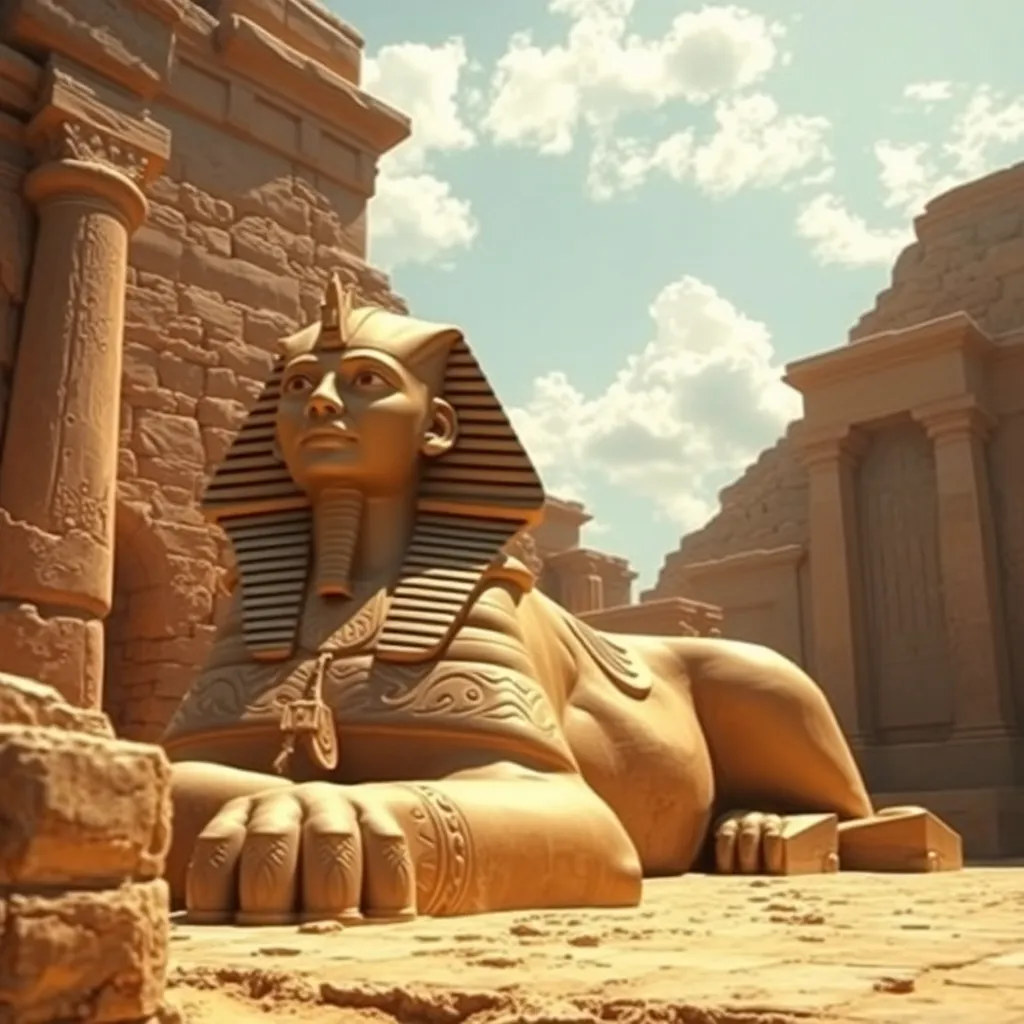The Sphinx: A Guardian of the Tombs
I. Introduction
The Great Sphinx of Giza is one of the most iconic monuments of ancient Egypt, representing a significant cultural and historical symbol. This colossal limestone statue, with the body of a lion and the head of a human, stands sentinel over the Giza Plateau, capturing the imagination of visitors and scholars alike. The Sphinx is not merely a remarkable architectural feat; it embodies the spiritual and religious beliefs of the ancient Egyptians, particularly in relation to the afterlife and the protection of the tombs.
This article explores the multifaceted role of the Sphinx as a guardian of the tombs, delving into its historical background, architectural features, connections to mythology, and its lasting legacy in contemporary culture.
II. Historical Background
A. Origins of the Great Sphinx of Giza
The Great Sphinx is believed to have been constructed during the reign of Pharaoh Khafre, around 2500 BCE, as part of a larger funerary complex that includes the nearby Great Pyramid. The Sphinx is carved directly from the bedrock of the Giza plateau, making it a unique and monumental work of art in ancient architecture.
B. Theories about its construction and the Pharaoh it represents
While Khafre is the most widely accepted identity for the Sphinx, some scholars theorize that it may represent another Pharaoh, such as Khufu or even a goddess. Theories about its construction methods range from the use of simple tools available at the time to more complex techniques involving a large workforce. The exact purpose of the Sphinx, however, remains a topic of debate among historians.
III. Architectural Features
A. Description of the Sphinx’s structure and design
The Great Sphinx measures approximately 73 meters (240 feet) long and 20 meters (66 feet) high, making it the largest monolithic statue in the world. The face of the Sphinx is estimated to be about 5.5 meters (18 feet) wide, and its eyes, once adorned with precious stones, are thought to have held a powerful gaze that symbolized divine protection.
B. Symbolism of the lion-human hybrid form
The hybrid form of the Sphinx—part lion, part human—symbolizes strength, wisdom, and protection. In ancient Egyptian culture, lions were revered for their power and prowess, while human features imparted intelligence and a connection to the divine. This combination reflects the Sphinx’s role as a guardian, watching over the tombs and the souls of the deceased.
IV. The Sphinx’s Role in Egyptian Mythology
A. Connection to the sun god Ra and the afterlife
In Egyptian mythology, the Sphinx is often associated with the sun god Ra, representing the cycle of life, death, and rebirth. The Sphinx’s alignment with the rising sun signifies its role in guiding souls to the afterlife and protecting them during their journey.
B. The Sphinx in Egyptian mythology and literature
The Sphinx appears in various ancient texts and stories, often depicted as a guardian figure. It is mentioned in the Pyramid Texts, where it is associated with funerary rituals and the protection of the Pharaoh’s soul in the afterlife. Additionally, the Sphinx’s riddles and wisdom have influenced later literary traditions, inspiring stories of challenges and quests throughout history.
V. The Sphinx as a Guardian
A. Functions of the Sphinx in funerary practices
The Sphinx served multiple functions in funerary practices. Positioned at the entrance of tombs and temples, it acted as a protector against evil spirits and intruders. The Sphinx was believed to shield the deceased from harm, ensuring a safe passage to the afterlife.
B. Protective symbolism associated with the Sphinx
- The Sphinx’s lion body represents strength and bravery.
- The human head symbolizes intelligence and wisdom.
- Its gaze is thought to ward off malevolent forces.
In this way, the Sphinx embodies a powerful protective force in ancient Egyptian belief, reflecting the importance of safeguarding the tombs and the souls of the departed.
VI. Archaeological Discoveries
A. Significant findings around the Sphinx site
Archaeological excavations around the Sphinx have revealed a wealth of artifacts, including votive offerings and inscriptions that provide insights into the religious practices of the time. These discoveries underscore the Sphinx’s importance as a site of worship and reverence in ancient Egypt.
B. Insights into the Sphinx’s history from recent excavations
Recent excavations have uncovered evidence of a complex network of temples and structures associated with the Sphinx, suggesting that it was part of a larger spiritual landscape. Studies of the Sphinx’s weathering patterns have also raised questions about its age and the environmental conditions during its construction.
VII. Cultural Impact and Legacy
A. The Sphinx in modern culture and art
The Great Sphinx has transcended its ancient origins, becoming a symbol of mystery and intrigue in modern culture. It has inspired countless works of art, literature, and music, often depicted as a guardian of ancient secrets.
B. Its influence on literature, film, and tourism
- The Sphinx appears in numerous films, often portrayed as a mystical being.
- Literature, such as “The Sphinx” by Edgar Allan Poe, draws on its symbolism.
- Tourism to the Sphinx remains a significant draw, with millions visiting each year to witness its grandeur.
This enduring fascination highlights the Sphinx’s role as more than just a historical monument; it is a cultural icon that continues to inspire awe and wonder.
VIII. Conclusion
The Great Sphinx of Giza stands as a testament to the ingenuity and spiritual depth of ancient Egyptian civilization. Its role as a guardian of the tombs underscores its importance in the context of funerary practices and the belief in the afterlife. As we reflect on the Sphinx’s enduring legacy, it remains a symbol of mystery and reverence, captivating the imagination of people around the world.
In contemporary society, the Sphinx continues to evoke curiosity and admiration, reminding us of the rich cultural heritage of ancient Egypt and the timeless questions of existence, life, and death.




